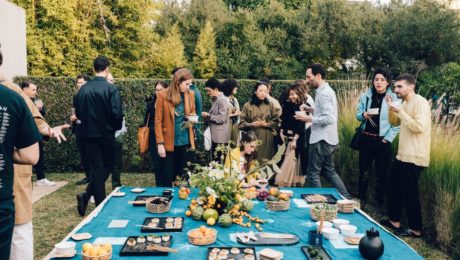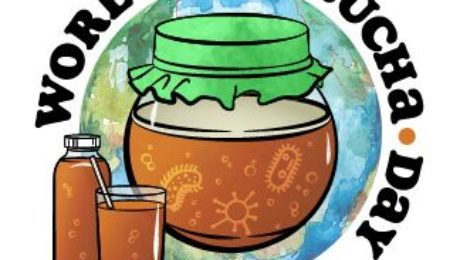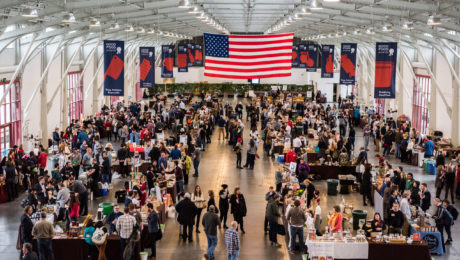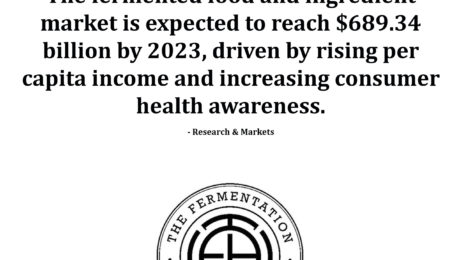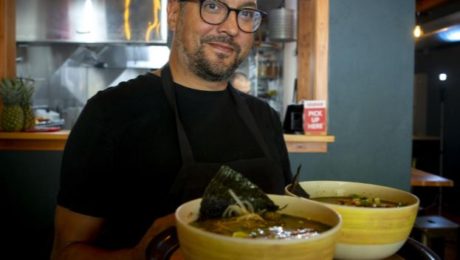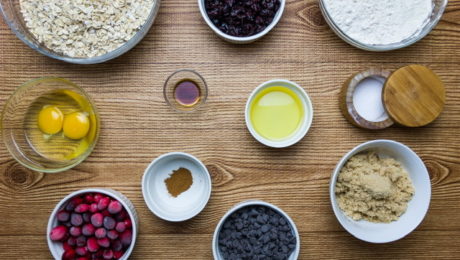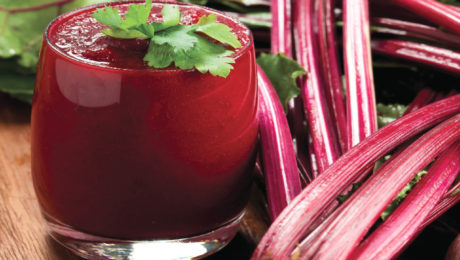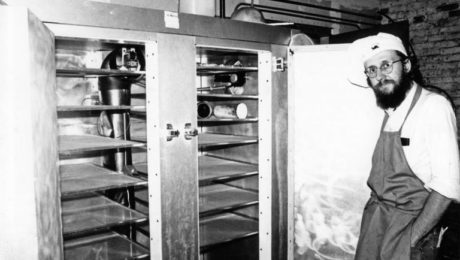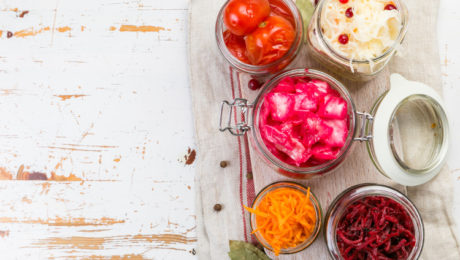Historic LA Home Becomes Experimental Fermentation Kitchen
A historic home in Los Angels is now an experimental kitchen, highlighting fermentation, art and design. The Schindler House hosted an event last month featuring a fermentation-based installation. Stone vessels were filled “with different combinations of soybeans, koji, barley, brown rice, citrus, salt and microbes. Several months later, the altered (mushier) contents of the containers, which had sat in the outdoor hearth of one of the house’s courtyard’s, became key ingredients in an afternoon that was part art happening and part cocktail party.” From the New York Times article: “Over the past decade, chefs and diners have been drawn to all manner of fermented produce, as well as to fermented staples like kombucha and kimchi, sourdough and cider, for their tangy flavors and presumed digestive health benefits. Perhaps surprisingly, so have artists, though for their own reasons. ”
Read more (New York Times)
- Published in Food & Flavor
“This is the Decade When Kombucha Becomes a Household Name”
Kombucha has its first international holiday. On February 21, kombucha brewers and consumers around the world will celebrate World Kombucha Day.
Kombucha dates back over 2,000 years to 221 B.C. The fermented tea is one of the fastest growing beverages in the world. Kombucha is estimated to reach $3.5 billion in international sales by 2025, with one third of that in U.S. sales. Hannah Crum, founder and president of Kombucha Brewers International (KBI), a non-profit trade association (and an affiliate of TFA), believes 2020 will be the decade kombucha becomes mainstream.
Educating the public, though, is the key step to making kombucha a recognized wellness drink. KBI began the World Kombucha Day initiative and is encouraging brands to host events, offer free tastings and partner with retails for in-store promotions.
Since KBI started six years ago, Crum has watched the small kombucha labels that joined KBI transform into big brands. She sees the kombucha industry growing not with big kombucha labels but with small craft brands. If consumers in small towns all over the world start purchasing kombucha, local producers will need to drive that growth, Crum adds.
“And it opens the door for all these other fermented products to come in,” Crum adds. “Drinking vinegar, shrubs, water kefir, even sauerkraut and fermented vegetables. Local brands will drive the entire fermented food and drink category.”
Below, a Q&A with Crum on World Kombucha Day and how kombucha can maintain their growth momentum.
Question: Why a World Kombucha Day?
Hannah Crum: Kombucha’s mythological origins hearken back to 221 BC in China. The Chinese are famous for their quest for longevity with their elixirs. It’s been part of the story of kombucha, this mythological origin. So 221, at least in the American system, translates to February 21st. What better year to launch it than in 2020.
Why World Kombucha Day? To celebrate the culture of kombucha. Obviously drinking a commercial brand is how I first heard about kombucha. It’s how most people first experience kombucha, even though home brewing has been around for a long time. It’s a way for people to raise awareness about kombucha, to be excited about what it is, to honor its Asian roots, and to really help more people know about kombucha.
This is the decade when kombucha becomes a household name. Launching this world kombucha day in 2020, in this decade, is that first step towards building excitement around kombucha. Not just the drink being trendy, because i think it’s going to last longer than a trend. It’s getting more people to wake up to how wonderful this product is.
We think of kombucha as a gateway. Kombucha isn’t an end point. We don’t stop at kombucha, we start with kombucha. From kombucha, people move to other products in the fermentation association, now it’s sauerkraut and kimchi and kvas and water kefir. I don’t even think we could see this many water kefir brands starting to emerge if kombucha didn’t exist.
Q: Tell me the process of making World Kombucha Day an official “day.”
HC: The process is pretty straight forward and basically just means coming up with the day and promoting it. We have applied to some of the calendars and apparently if you pay enough money, you can even make it onto the National Holiday Calendar.
Q: What are you hoping brands will do to celebrate World Kombucha Day?
HC: I’m hoping they’ll elevate kombucha into the consciousness. That can be providing education, and education could come in the form of free samples or offering a promo at your favorite store. It’s on a Friday this year — if you happen to be at a farmers market or you happen to have a tap room, why not host an education event.
Really it’s this opportunity to engage with your community, do this outreach and to help people understand what kombucha is. Because so many people still either haven’t heard the word, they don’t know what it is, they’re afraid of it, they’ve tried it and think its weird, whatever it is, just giving them another touch point, another opportunity to hear about it, another opportunity to try it without having to pay $3-5 per bottle in order to see what it’s like.
People can add events to our World Kombucha Day calendar based on region. This is free, open to all kombucha producers, not just KBI members. While World Kombucha Day is a KBI initiative, it’s really about the category of kombucha.
Q: Tell me more about KBI origins. Why did you create KBI ?
HC: It started with our business, Kombucha Kamp, and our mission: changing the world, one gut at a time.
KBI also comes from looking at our culture which works in symbiosis. We’ve always understood we can’t do this alone, we have to do this in partnership, we have to be in community. Changing the gut one world at a time, knowing we can’t do it alone, and how do most people find out about kombucha? Again it’s through a commercial product.
In 2010, we had that incident where Whole Foods took all the kombucha off of store shelves and it really creates a lot of fear. It’s a trauma point that we’ve continued to have to work through together. That is what inspired us to come together and really make this work.
We know: people don’t really understand what kombucha is. When you don’t know about something, you’re afraid of it. People worry “I’m going to get bad bacteria in my brew and harm myself.” Well, that’s highly unlikely, just like any fermented food. The only reason they still exist today is because they’ve always been so incredibly safe to make and pass around or they would have been on the compost heap of history ages ago.
So knowing that there was a need, we have a unique roll. We’ve already been doing some cross-category marketing. We did a 30-day kombucha challenge, we did a New Years re-evolution, which were all designed to raise awareness about the category.
So I nominated myself to head KBI and Alex (Crum’s husband), God love him, supported me. We started with KKon (KombuchaKon) in 2014, and here we are about to have our 7th annual show, our 5th annual trade show. We’ve grown from 40 members to over 300. We’ve always been international though, which is unique. We’ve always had people from around the world participating with us.
Q: Is the U.S. leading the growing kombucha popularity?
HC: Yes. America leads the world because this is where the commercial industry started. GT’s is going to celebrate his 25th anniversary this year. Kombucha has been a commercially available product for 25 years. Even now its taken this long, right, even in the early years it wasn’t around until 2010 when it started to pick up steam and we started to see more brands proliferate. Now here in 2020, we’re going to make it a household name.
Just like yogurt wasn’t a household staple, it was something hippies had to make at home on their countertops themselves, then it was turned into a multi-billion dollar industry. And that’s exactly what we see kombucha becoming. What we see isn’t the opportunity for a bunch of processed food companies. Rather its a bunch of small, family-owned businesses that serve local communities with a fresh product. That’s what’s different and unique about all the fermentation businesses.
I love Farmhouse Cultures — I just bought a bottle of their kraut juice — I look on the back and they’re adding vinegar to it. You can’t keep up when you’re a massive brand and you’re going to have to take shortcuts. To me, yes it tastes good, but its not kraut juice, its vinegar and kraut juice. Unfortunately, that’s just what happens when you go too big with certain things.
People in the 21st Century are looking for viable opportunities with a job that makes you feel good about the work you’re doing and that helps your local communities, and it’s important for these communities to have access to really fresh, nutrient-dense foods. So I always advise people: there’s an opportunity, as long as you’re not afraid of hard work. I advise people its a labor of love, emphasis on the labor. But I also think that if you’re someone who wants to be in your community doing good, this is a great way to do it.
Q: Do you think that’s how the kombucha industry is going to grow — more small producers than large?
HC: Exactly right. There’s always going to be a certain number of large producers and brands that want to pursue that type of dream, but it’s a huge trade off. Sure you might end up with a bigger paycheck in the end, but you also give up so much of your life and energy in order to make it profitable.
You’re never going to have another GT’s Kombucha. He was first to market. That was a rare opportunity. Were not likely to see an individually or privately owned brand get to that type of level unless they have investment and if you take on an investment, now you are beholden to other people’s ideas about your business.
Look at the beer industry and how things have happened there. New Belgium just sold to a major food corporation from Asia because even economies of scale aren’t sustainable if you don’t continue to have capital infusions. So if you’re looking for a model that will stay sustainable over time, I think it is staying small, having a local footprint, and again that’s better for the planet, better for the community. The reason products need super long shelf lives on them is because it’s being shipped massive distances. If you only have to go to your local place to get kombucha fresh, you don’t have to put so much processing into your products.
Q: Tell me what you’re seeing in the industry now — are craft beer brewers entering the market? Bigger commercial soda brands?
HC: All of these entrants, it’s exciting. What they are seeing are dollar signs and opportunities. Especially as they see their sales slipping. It’s true for craft beer as it is for soda.
That’s just reflecting how consumers are changing their tastes over time. It’s always healthy to diversify. The reality is what we would love — Coca-Cola started as a health drink, selling in pharmacies, with actual essences and things that were good for you. And now it’s turned into a fake version of a real thing, full of fake ingredients. How wonderful would it be for us as an industry, for us to bring them back to the good side. Don’t poison people with your cheap products and aspartame and things that are known to be toxins. Let’s try to make this something that brings about positive change to everybody.
We love beer too! I think what we’ll also start to see is the benefits of unfiltered beer. I personally believe that pasteurization and these processing steps that remove the yeast or all of the living nutrients from beer basically creates products that don’t deliver on the nutritional promise that was guaranteed for our ancestors.
We crave bubbles because our ancestors understood that meant that nutrients were present in a living form. And so many people have come to find they can’t tolerate carbonated water — well that’s carbonic acid, it’s not natural organic acids, it’s not all of the yeast and nutrients present in yeast.
The conflict is always these are tough products to control. That’s again where the model of having several small producers is actually better.
Q: What are some of the greatest myths consumers believe about kombucha? How can brands debunk the myths?
HC: In the headlines, we get the two polarizing viewpoints — kombucha is the miracle elixir that will save your life and kombucha is snake oil that is dangerous. The reality is the truth is always somewhere in the middle. This is not a beverage for everybody. That’s because we have so many people dealing with a healing crisis. However, there is a ferment for everyone. So either its a miracle cure — or it will kill you. Both of those are the greatest myths.
Will you feel a benefit from drinking kombucha? Absolutely. We have a research study we presented last year showing how kombucha impacts inflammation and stress markers. They’ve taken that study to the next step, which we’ll be hearing those results at KKon this year.
People have provided anecdotal information for how kombucha has helped them with a wide range of inclement for hundreds, thousands of years, right. And so often science wants to ignore that information. But truly that’s the jumping off point for studying something, for understanding something. It is because of the anecdotal information.
Science is a method of inquiry. The phenomenon already exists. We just don’t necessarily know what’s driving it until we engage in scientific inquiry. So this idea that science is settled, that we already know everything, is ridiculous. It’s human hubris to think that. What I think is exciting is in this 21st Century, we continue to do the research and validate the anecdotal claims, and again not everything is for everybody. Some people are allergic to shrimp, strawberries, you name it, there are people who can be allergic to anything and all that says is we’re diverse and not everything is for everybody and that’s OK. Honestly, I think what’s exciting about our industry is you try one kombucha and don’t like it — try another. It’s going to taste totally different. It’s not a miracle, but it’s not going to kill you. It’s not for everyone, but it helps a lot of people. And that’s what World Kombucha Day tries to do — to introduce you to kombucha and see where you land on that spectrum.
Q: What is driving kombucha’s popularity in the past few years?
HC: Microbiome. The rise of autoimmune disease and metabolic disease. People are sick of being sick and start to turn to food to get better because they’ve heard you can get better with certain types of food or by changing their diet. And while they are not getting that advice from their doctors, unless they’re seeing a naturopath or something like that, I think people out of desperation are turning to their diet because they’re just so uncomfortable with where they’re at healthwise. That to me is truly what’s fueling the fueling popularity of this product. So many people consume it, and they say they “Just feel good.” What does that mean, how do you quantify that? Is it just my tummy feels more settled? There’s a whole range of things that could refer to. And I think that’s really what’s driving it.
People are waking up. They realize now they’ve been lied to by packaged foods — I call it poisoned in prepackaging by pretty people. How many sodas is Beyonce drinking to be that shape? You know there’s mythology when they’ve put these packages in people’s hands but that’s not who’s actually drinking this on a regular basis.
Especially this younger generation is more critical of advertising and more critical of doing what everyone else has done until now. They are starting to recognize “Hey what are all these weird flavorings and chemicals in my food and water?” and “Hey I thought someone was in charge of and managing this?” and then you find out, no, corporations are actually still allowed to dump toxins into the water supply, we still have lead in Michigan and Flint. This mythology of a government that cares for you is being broken down. For good reason. Unfortunately, the forces that be are trying to maintain a status quo because they make money off people being sick for so long. But that really is that change — I’m not saying kombucha will cure everything. Buts it’s a gateway. It’s a gateway to healing your body, getting some kind of relief, and seeing there’s a world of other choices you can make that are going to yield different health benefits.
Q: The soda industry is rapidly declining. Do you think kombucha can capture those consumers?
HC: One thousand percent. Really Who is our competition? It’s not other kombucha brands. Its soda companies, it’s energy drink companies, it’s soda water companies, it’s seltzer water companies, it’s “smart water” that’s water with some electrolytes, it’s Gatorade. It’s all this manufactured, lab-created junk. Supplements will never be as good as the real thing. And kombucha is a real thing — it’s a real fermented beverage. It’s what soda aspires to be.
- Published in Science
Dozens of Fermented Food & Drink Brands Win Good Food Awards
Fermented food and beverages reigned at the 2020 Good Food Awards. The annual Good Food Awards honors American craft food producers. Over a hundred fermented brands beat out 1,835 entrants to take home top honors.
Craft food makes over $200 billion in revenue a year. The 17 categories include: beer, charcuterie, cheese, chocolate, cider, coffee, confections, elixirs, fish, grains, honey, oils, pantry, pickles, preserves, snacks and spirits.
From the Good Food Foundation: “For a long time, certifications for responsible practices and awards for superior taste have remained distinct – one honors social and environmental responsibility, while the other celebrates craftsmanship and flavor. The Good Food Awards recognizes that truly good food – the kind that brings people together and builds strong, healthy communities – contains all of these ingredients.”
Read our article for an overview on the fermentation brands that won awards this year.
1000 Faces Coffee – Luis Ordoñez (Athens, Georgia). With a “mission to connect the coffee consumers and coffee producer,” 1000 Faces Coffee is a coffee roaster that travels to countries of origin to work with producers.
21 Degrees Estate Cacao Farm – Kahalu`u Gold (Kaneohe, Hawaii). A family-operated boutique cacao farm on the windward side of the island of Oahu. 21 Degrees sells chocolate and offers tours.
Albemarle CiderWorks – Harrison (North Garden, Virgina). A 20-year-old apple orchard, CiderWorks makes 15 varieties of cider in their cideries, selling by the bottle or by glass in their taproom.
Aldi – VitaLife Organic Ginger Awakening Kombucha (Batavia, Illinois). The fermented tea is made by VitaLife, a brand made by the discount supermarket chain Aldi.
Allagash Brewing Company – Crosspath (Portland, Maine). This independent craft brewer sells beers using a traditional, Belgian method of spontaneous fermentation.
Almanac Beer Co – Apricot Sournova (Alameda, California). Farm-to-barrel brewing, Almanac uses mixed-culture to make their beers, which allows continuous fermentation over months with real fruit in oak barrels.
Apologue Spirited Liqueurs – Saffron Liqueur (Chicago, Illinois). A locally-sourced liquer maker that “elevate classic cocktail recipes.”
Askinosie Chocolate – Dark Chocolate & Red Raspberry CollaBARation™ Bar (Springfield, Missouri). One of Forbes’ 25 Best Small Companies In America, Askinosie Chocolate uses single origin, Direct Trade cocoa beans.
Atlantic Sea Farms – Sea-Chi (Saco, Maine). The first commercially viable seaweed farm in the U.S., Atlantic Sea Farms was founded in 2009. The clean, fresh Sea-Chi is made with raw kelp, cabbage and radish.
Backyard Beans Coffee Co. – Ethiopia Basa (Lansdale, Pennsylvania). A coffee roaster using responsibly sourced coffee beans, the light roast is an Ethiopian heirloom variety.
Barrington Coffee Roasting Company – Gera (Lee, Massachusetts). Sustainable coffee with delicate violet and blueberry aromas with fruit flavors of strawberry, peach and hard candy and soft tones of cocoa, molasses and licorice root.
Beltex Meats – Pate Forestier (Salt Lake City, Utah). A nose-to-tail, whole animal butcher sourcing regional meat, Beltex Meat’s Pate Forestier is part of the in-house charcuterie program. It’s comprised of pork shoulder and liver, chicken liver, and foie gras.
Big B’s Hard Cider – Harry Masters Jersey (Hotchkiss, Colorado). A farmstead hard cider made with fruit from the orchard and fermented in the cidery.
Big Easy Bucha – Bayou Berry Kombucha (New Orleans, Louisiana). A kombucha brand fermented with Southern flavors. Bayou Berry is infused with strawberry and honeysuckle.
Blackberry Farm – Sobrasada (Walland, Tennessee). Sobrasada is Blackberry Farm’s version of a raw, cured, fermented Spanish sausage, made from American Iberico pigs raised at White Oak Pastures in southern Georgia.
Blackberry Farm – Brebis (Walland, Tennessee). Blackberry Farm’s seasonal fresh sheep’s milk cheese.
Blackberry Farm – Hawkins Haze (Walland, Tennessee). An ashed surface-ripened sheep’s milk cheese named after the Hawkins line that runs through the property.
Blue Bus Cultured Foods – Local Cortido (White Salmon, Washington). A sauerkraut popular in Salvadoran cuisine, the organic kraut is made with cabbage, carrots, onions, garlic and spices.
Bourbon Barrel Foods – Imperial Double Fermented Soy Sauce (Louisville, Kentucky). Naturally brewed, double fermented soy sauce. It is aged in bourbon barrels and features earthy flavors.
California Fish Sauce – Koji Fish Sauce (Pleasanton, California). The first fish sauce in the U.S. that is compliant with FDA and FDB regulations, from harvesting anchovies to fermentation and finished product.
Capriole – Sofia (Greenville, Indiana). A sweet, dense, ripened goat cheese from local goats.
Cascadia Creamery – Sleeping Beauty (Trout Lake, Washington). A buttery and sharp cheese with a natural rind, aged 75 to 100 days.
Case Coffee Roasters – Ethiopia Dimtu (Ashland, Oregon). Sustainably sourced coffee from beans all over the globe. Roasted in small batches for sweeter, complex flavors.
Casella’s Salumi Speciali – Casella’s Prosciutto Speciale (Hurleyville, New York). An American made meat made using Italian tradition. Slow, on-the-bone curing.
Castronovo Chocolate – Tumaco, Colombia Dark Milk 60% (Stuart, Florida). A dark milk chocolate made with cocoa from the Pacific coast of Colombia. The cacao beans are foraged in indigenous forests, then fermented and dried in an onsite facility using solar panels.
Champlain Orchards Cidery – Honeycrisp (Shoreham, Vermont). A single-varietal cider using fresh-pressed Honeycrisp apples. All apples are pressed, fermented, and crafted at the orchard.
Champlain Orchards Cidery – Redfield – Estate Series (Shoreham, Vermont). Made with estate grown Redfield apples. These red crab apple hybrids create a fragrant, sour cherry flavor.
Chequessett Chocolate – White Lemon Thyme Bar (North Truro, Massachusetts). A white chocolate with lemon and thyme, the chocolate-making process begins with high-quality beans, then a flavor developed during fermentation.
Cherry Grove Farm – Havilah (Lawrenceville, Nj, New Jersey). Cheese from the cows at Cherry Grove Farm, a sustainable farm. Batches are aged 14 to 16 months.
Cleophus Quealy Beer Company – Frambozenbier (San Leandro, California). Sour red ale barrel-aged with raspberries. Small batches are brewed seven barrels at a time.
Compelling Coffee – Ethiopia Bedhatu Jibicho (Los Angeles, California). Beans are fermented in ceramic tile tanks filled with clean spring water for 24 hours. The beans are then fermented a second time for another 24 hours.
Creo Chocolate – Caramelized Milk Chocolate (Portland, Oregon). The fruit inside the cacao bean is fermented for 4- 7 days to bring out the flavor of the beans.
Crimson Cup Coffee & Tea – Kossa Kebena (Columbus, Ohio). From Crimson Cup’s line of Friend2Farmer direct-trade coffees, Kossa Kebena is produced from heirloom cacao beans naturally fermented on raised beds.
Cutwater Spirits – Three Sheets Cask Strength Rum (San Diego, California). Crafted from pure cane sugar rather than molasses, the rum is distilled in a hybrid pot-and-column still.
Daniel’s Artisan – Bonneville (Ferndale, Washington). Traditional, artisan cheese made through Ferndale Farmstead cheese company. Ferndale uses a seed-to-cheese philosophy, only using milk they produce from cows they raise, fed from crops they grow.
Equator Coffees – Panama Hacienda La Esmeralda Gesha (San Rafael, California). A light roast sustainably sourced from Panama, it features flavors of peach, apricot and Meyer lemon.
Falcon Spirits Distillery – Aperitivo Aplomado (Richmond, California). A blend of 26 high-quality herbs, roots, flowers and fruits with no artificial flavors. Made in small batches that take two months to create.
Fra’ Mani Handcrafted Foods – Salame Toscano (Berkeley, California). All natural pork made in the Tuscan tradition.
Fruition Chocolate – Spring Salted Dark Milk 56% (Shokan, New York). Seeds from pods are fermented in bins and covered with burlap or banana leaves for 3-8 days.
Fullsteam – Farm’s Edge: Barrel-Aged Ava (Durham, North Carolina). A mixed culture saison made with foraged wild grape leaves and elderflower and rested in red wine barrels.
Goat Rock Cider Company – Rosé Cider (Healdsburg, California). A fruit cider made by co-fermenting local, organic apples with Hawaiian passion fruit.
Goodnow Farms Chocolate – Special Reserve with Las Palomas Coffee (Sudbury, Massachusetts). A single-origin coffee and cacao bar, the chocolate is a fruity flavor thanks to the Guatemalan coffee beans.
Gowan’s Heirloom Cider – Macintosh Applewine Cider (Philo, California). A farm-to-table cider, the Macintosh apples used in the cider are grown at Gowan orchards to be pressed, fermented and bottled at the farm.
Gowan’s Heirloom Cider – Gravenstein Cider (Philo, California). Called summer in a glass, the cider is made using fresh Gravenstein apples from the farm’s heritage orchards.
Green Dirt Farm – Fresh – Plain (Weston, Missouri). A fresh, spreadable cheese.
Gypsy Circus Cider Company – PuppetMaster: Whiskey Barrel Vaudevillian (Kingsport, Tennessee). A wild cider aged in whisky barrels for 15 months with apricots.
H+S Coffee Roasters – Kenya Chwele (Laramie, Wyoming). A Kenyan coffee with complex flavors of raspberry, black plum, sour skin, cherry taffy, mango, tropical fruits and stone fruits.
Hemly Cider – Sloughouse Jalapeno Pear Cider (Courtland, California). Made on a six-generation farm, the cider starts with hand-picked Bartlett pears blended with estate grown Gala apples.
HOSAco – The Standard Fermented Hot Sauce (Bellingham, Washington). A condiment made in small batches with all-natural ingredients. Chiles are hand processed and fermented for a minimum of six weeks.
Idyll Farms – Mont Idyll (Northport, Michigan). Named a “Best Artisanal Cheese” by Food & Wine Magazine, the soft ripened rind is delicately painted with vegetable ash.
Incontro Cured – Salame di Bue (Richmond, California). Made from a Sanke River Farms American Wagyu.
Incontro Cured – Salame Sicilia (Richmond, California). Salame honoring the Sicilian lineage, it’s made from ingredients growing wildly throughout the Island of Sicily, Italy.
JAZ Spirits – Cold Tree Gin (Clackamas, Oregon). Inspired by the elegant old growth forests of Oregon, a spirit crafted with flavors of botanical, fruit and old tree harvests.
JAZ Spirits – Verstovia Spruce Tip Vodka (Clackamas, Oregon). A vodka foraged from the coastal forests of the Pacific Northwest, distilled with the fresh green tips of Sitka Spruce trees.
JBC Coffee Roasters – Janson Geisha Lot #109 (Madison, Wisconsin). Direct trade coffee that is named one of the best coffee roasters by Forbes.
Kickapoo Coffee – Kenya Mbeguka (Viroqua, Wisconsin). Made with a Kenyan coffee bean, the coffee is made with a dry fermentation.
Klatch Coffee – Colombia Finca La Maria Geisha Natural (Rancho Cucamonga, California). The highest-scoring coffee at the 2019 U.S. Brewing Championships, the coffee has flavor notes of raspberry, black tea and floral flavors.
KMN Enterprises – K Bloody Mary Mix (Brooklyn, New York). Made in small batches using 87% organic ingredients.
Lakefront Brewing – Beerline Barleywine (Milwaukee, Wisconsin). The nation’s first organic barrel-aged barley wine in the U.S., the beer is held for 18 months in rye whiskey barrels.
Leopold Bros – Summer Gin (Denver, Colorado). Ingredients include Spanish blood oranges, French immortal flowers, juniper berries and Australian lemon myrtle.
Letherbee Distillers – Original Label Gin (Chicago, Illinois). Gin incorporated with a blend of 11 botanical spirits.
Liberty Ciderworks – English Style IV (Spokane, Washington).Classic cider in a aroma-rich, English-style cider.
Linea – Guatemala El Injerto Reserve (San Francisco, California).Coffee from Guatemala’s first carbon-neutral certified farm.
Little Apple Treats – Strawberry + Pink Peppercorn Shrub (Sebastopol, California). Fresh, organic strawberries and fresh, organic pink peppercorn leaves and fruit combine with award-winning apple cider vinegar. It contains live vinegar mother, so it’s potent with probiotics.
Little Beast Brewing – Bes – Tart Wheat Ale (Beaverton, Oregon). Brewed with Belgian malts, Lemon Drop Hops and chamomile flower then fermented with a blend of unique Saccharomyces yeast and conditioned with Lactobacillus.
Little Beast Brewing – Golden Stone (Beaverton, Oregon). A blend of peaches, nectarines and apricots gives a luscious elegance to this farmhouse ale. Prevailing notes of vanilla, toasted French oak & juicy stone fruit.
Loma Coffee – Ethiopia Shantawene Village – Anaerobic Process (Portland, Oregon). Heirloom coffee from Ethiopia, this coffee is anaerobic fermented and tastes floral, sweet and complex.
Love Hard, Inc. – Jojo’s Sriracha – OG (Pueblo, Colorado). Handmade Sriracha made with chile peppers from small farms in Pueblo, Colorado. The chili peppers are harvested in-season and fermented for several months.
Madrone Cider – The Reserve Blend (Friday Harbor, Washington). Naturally fermented in bottle, apples are sourced from Bellevue Farms on San Juan Island, Washington. The hard cider apples are bred specifically for flavor.
Mudhouse Coffee Roasters – Moras Negras, Mi Finquita Coffee Farm (Charlottesville, Virginia). A sundried, natural processing style, the coffee features complex fruit and floral flavors.
My Artisano Cheeses – Ervie Cheese (Cincinnati, Ohio). Washed rind soft cheese with balanced cream, and yeasty notes. Amild version of Belgian washed rind cheeses.
Napili Fresh Local Organic Farm – Pineapple, Ginger, Turmeric Sauerkraut (Lahaina, Hawaii). Artisanal, naturally fermented sauerkraut made in Hawaii with organic ingredients.
Napili Fresh Local Organic Farm – Gut Shots (Lahaina, Hawaii). Kimchi gut shots handcrafted in Maui.
Nettle Meadow Farm – Kunik (Warrensburg, New York). Artisanal goat cheese made on a 100-acre farm.
Oak Cliff Coffee Roasters – Carmen Geisha (Dallas, Texas). A micro-roaster, the Carmen Geisha is a small batch sourced from Finca Carmen in Volcán, Panama
OlyKraut – Eastern European Sauerkraut (Olympia, Washington). One of the most popular flavors, the caraway seeds and apple give it a distinct flavor in the live probiotic kraut.
OlyKraut – Organic Smoke & Kale Sauerkraut (Olympia, Washington). Combines smoked chiles with local kale bounty from Pacific Northwest farmers.
Olympia Provisions – Chorizo Rioja (Portland, Oregon). A Spanish-style salami with both sweet and smoked paprika, garlic and oregano.
Olympia Provisions – Rosette de Oregon (Portland, Oregon). A French-inspired salami made with all Oregon ingredients: Oregon pork, pinot noir, rosemary, juniper, and sea salt.
Oregon Brineworks – Sauerkraut (Hood River, Oregon). Naturally fermented, raw sauerkraut made with organic, lacto-fermented vegetables.
Pagosa Brewing & Grill – Cool Cucumber Wheat (Pagosa Springs, Colorado). A fruit beer infused with fresh cucumbers.
Pappy & Company – Pappy Van Winkle Bourbon Barrel Aged Pure Maple Syrup (Louisville, Kentucky). A one-of-a-kind syrup bursting with flavors of vanilla, butter, oak and bourbon. Aged in Pappy Van Winkle bourbon barrels.
Patric Chocolate – 67% Madagascar (Columbia, Missouri). A limited release bar made from American craft chocolate company from the cocoa bean.
Patric Chocolate – 67% Piura Peru (Columbia, Missouri). Peru cacao beans create chocolate with ruby grapefruit, toasted almonds and sun-dried wine grapes.
Pennyroyal Farm – Reserve Boont Corners (Boonville, California). Made of fresh, raw milk, it is inspired by French cheese as a means of preserving nutrients from the abundant summer milk.
Penstock Coffee – Taaroo Mill, Ethiopia (Highland Park, New Jersey). The coffee is fermented for 24-36 hours, then dried for 12-20 days. The coffee is intensely sweet with heavy fruits.
Perennial Artisan Ales – Giant Steps: Blend 2 (St. Louis, Missouri). A 50/50 blend of two distinct threads: Half puncheon fermented mixed culture saison with grapefruit zest and juice, and half barrel fermented clean saison aged on 2nd use raspberries and blackberries.
Port City Brewing Company – Optimal Wit (Alexandria, Virginia). A a Belgian Witbier style beer, Optimal Wit includes ingredients like Virginia-grown wheat, Spanish orange peels, and coriander.
Port City Brewing Company – Rivershed Ale (Alexandria, Virginia). An American Pale Ale (APA) style beer, Rivershed Ale is dry-hopped with 100% locally sourced grain.
PUSH X PULL COFFEE – Ethiopia Sidama Shantawene Anaerobic Process (Portland, Oregon). Ethiopian coffee with flavors of strawberries and tangerine.
Real Pickles – Organic Nettle Kraut (Greenfield, Massachusetts). Naturally fermented, small batch kraut, infused with Vermont nettles.
Real Pickles – Organic Beet Kvass (Greenfield, Massachusetts). Fermented infusion of beets, onions and savory herbs.
Red Rooster Coffee Roaster – Ethiopia Nansebo Worka (Floyd, Virginia). This washed process organic coffee is sourced from the Zenebe Simbret Washing Station, Flavors include honeysuckle and rose aroma, sweet ripe plum, fresh apricot and pomegranate acidity.
Reuben’s Brews – Hazealicious IPA (Seattle, Washington). An IPA with tropical fruit notes, in particular passion fruit. The stars of the show are the big, bright hops with restrained bitterness providing balance.
Reverend Al’s Bona Fide Potents – Strawberry Peppercorn Shrub (Tacoma, Washington). Reverend Al’s Bona Fide Potents are a collection of all natural, nearly mystical, alchemetical concoctions– magical bitters, elixirs, tinctures and shrubs. Made with locally grown fruits and vegetables from family farms.
Salt and Savour – Apple Ginger Sauerkraut (Dunsmuir, California). Fermented, organic sauerkraut, handcrafted in small batches.
Salute! – Vicario Amore Mio Aperitivo (Greer, South Carolina). Made with a 115-year-old recipe using “vanishing” herbs, hard to find herbal ingredients that Salute now grows themselves.
Shrub Farm – Ginger & Hawaiian Chili Shrub (Bellingham, Washington). A spicy ginger and chili shrub. Shelf stable with a living culture with the Mother of vinegar.
Sierra Nevada Cheese Company – Bella Capra Raw Milk Monterrey Jacques (Willows, California). Made with raw cultured goat’s milk, the “complex array of flavors” results from “naturally occurring healthy micro-organisms present in our fresh milk.”
SILO Distillery – Vodka (Windsor, Vermont). Made with 100% Vermont corn, gluten-free and non-GMO.
Smoking Goose Meatery – Whey Fed Dodge City Salame (Indianapolis, Indiana). Old world style of meat curing with a new world flavor. The Dodge City Salame is a pork salame of fennel pollen and pink peppercorns.
Smoking Goose Meatery – Duck Prosciutto (Indianapolis, Indiana). Moulard duck breast with star anise, allspice and orange peel.
Speakeasy Ales & Lagers – Bootleggers Black Lager (San Francisco, California). Founded in 1997, Speakeasy Ales & Lagers is a San Francisco craft brewery bringing great beer from the underground to the masses. The brewery makes year-round and limited release beers.
Speckled Ax Wood Roasted Coffee – Ethiopia Jebicho (Portland, Maine). Coffee roaster in a vintage Italian Petroncini fired with local hardwood.
Spirit Works Distillery – Sloe Gin (Sebastopol, California). “Batch by batch – grain to glass.” Made with sloe berries, the crimson-colored gin has a unique sweet-and-sour taste.
Spyhouse Coffee Roasting Co. – Juan Domingo / Guatemala (Minneapolis, Minnesota). Rich flavors of chocolate hazelnut and deep fruitiness.
Steady State Roasting – La Pradera Mokka (Carlsbad, California). A Colombian coffee from the mokka tree.
Stem Ciders – New Hampshire Heritage (Lafayette, Colorado). Unfiltered cider made from a blend of bittersharp and bittersweet heirloom apples from a local orchard.
Stonecutter Spirits – Heritage Cask Whiskey (Middlebury, Vermont). The Heritage Cask Whiskey is distilled in Kentucky like a bourbon, aged in Vermont like an Irish whiskey, and finished like a Scotch.
Stormalong Cider – Light of the Sun (Sherborn, Massachusetts). A citrusy, refreshing cider dry-hopped with Citra & Ekaunot hops. At the time of dry-hopping, Stormalong Cider adds guava to enhance the tropical, citrusy taste which is on the drier side.
Sugar Bob’s Finest Kind – Smoked Maple Sriracha (Londonderry, Vermont). Made with real maple syrup, this all natural Smoked Maple Sriracha has become a cult favorite in the state.
Sweet Bloom Coffee Roasters – Mario Alarcon (Lakewood, Colorado). Specialty, ethical, sustainable coffee with limited release flavors, like Mario Alarcon.
The Cottage – Pickled West Indian Gherkin (Bluffton, South Carolina). Pickling cucumbers from The Cottage, a cafe and tea room founded in 1868.
The Juice Hive & Health Emporium – Shiso, Sweet Potato and Asian Sour Leaf Kimchi (Bluffton, South Carolina). A kimchi from the natural foods store.
The Juice Hive & Health Emporium – Watermelon Rind Kimchi (Bluffton, South Carolina). Another unique kimchi flavor from the natural foods store.
Top of the Hill Distillery – Organic Carolina Straight Wheat Whiskey (Chapel Hill, North Carolina). Made from North Carolina-grown wheat and U.S.-grown sugar cane. Fermented and distilled on-site in the distillery.
Treaty Oak Distilling – Ghost Hill Bourbon (Dripping Springs, Texas). Ghost Hill Bourbon is a unique whiskey made with local heirloom grains. A genuine grain to glass bourbon, it is mashed, fermented, distilled, barreled, aged 2 years and bottled on-site.
Underground Meats – Calabrian 3 Ways Salami (Madison, Wisconsin). Wisconsin-grown calabrian chillies, prepared three different ways
Urban Tree Hard Cider – Habanero Haze (Atlanta, Georgia). Spicy ginger infusion with hints of habanero zest.
Vibrant Coffee Roasters – Ethiopia Ardi Organic – Washed (Philadelphia, Pennsylvania). An organic Ethiopian coffee with citrus and sweet floral flavors.
Virtue Cider – The Mitten (Fennville, Michigan). A Michigan cider blend of last season’s pressed apples, aged in Bourbon barrels for up to one year, then back sweetened with this year’s fresh pressed apple juice. The Mitten has notes of vanilla, caramel, and charred oak.
Virtue Cider – Michigan Cherry (Fennville, Michigan). Michigan Cherry blends last year’s harvest of Michigan apples from local orchards that are aged in French oak barrels. Fresh-pressed juice from Michigan cherries is then added.
Vista Brewing – Stonewall Belgian Lambic-Style Ale with Texas Peaches (Driftwood, Texas). Lambic-style ale with Texas peaches.
Volpi Foods – Heritage Prosciutto (St. Louis, Missouri). Our heritage prosciutto is hand-rubbed, salted & air dried for a perfect melt-in-your-mouth texture.
Waialua Estate Chocolate – Hawaiian Milk Chocolate (Wahiawa, Hawaii). Waialua Estate’s Hawaiian cacao is grown along the banks of the Kaukonahua stream. Flavors include banana and pineapple notes, and flavors of dark cherry, berry and raisins.
White Label Chocolate – 58% Brown Butter Milk (Santa Cruz, California). Single origin chocolate bars fermented in a pair box design.
WildCraft Cider Works – Pisgah Heritage (Eugene, Oregon). Traditional farmhouse cider made with apples and English Hawthorne berries & blossoms.
Wise Goat Organics – Super Green Kraut (Hollister, California). Probiotic rich and full of raw, live cultures. Super Green Kraut is full of organic greens: cabbage, nettles, cilantro, morenga, spinach, parsley, chickweed and dandelion.
- Published in Business
Fermented Food & Ingredient Market to Reach $689.34 Billion by 2023
The fermented food and ingredient market is expected to reach $689.34 billion by 2023, driven by rising per capita income and increasing consumer health awareness.
Research & Markets
- Published in Business
Chef Explains Why Umami and Garum Are Key to Delicious Veggie-Based Dishes
You’ll never find Jon Bertolone, chef of Nourish in Oregon, serving an Impossible Burger. He says there are other ways to be inventive with a savory, plant-based patty. “Umami is something that has sort of driven my culinary journey,” Bertolone says. He’s been experimenting with garum (fermented fish sauce) to capture beef flavor, too. Fermentation, Bertolone says, is “the key to bridging cultures, because every culture has them.”
Read more (The Register-Guard)
- Published in Business, Food & Flavor
Fermented Foods Follow Trends in Ethnic, Earthy and Floral Flavors
2020 is the year of the adventurous eater. A new survey reveals 74% of people love to discover new flavors. The Innova Trends Survey highlights botanicals, spices and herbs as popular flavors that will drive the food and beverage market in the new year. Innova calls these trending ingredients as “functionally flavorful.”
Fermented food brands are active in this regard. Kombucha brands are adding more botanical flavoring to their beverages, and fermented vegetable products are experimenting with unique spice and herb combinations. Flavor is still the No. 1 factor for consumers when buying food and beverages. Fermented food brands can use the trending ingredients of 2020 to develop new products and experiment with new flavor combinations.
“Ingredients have become the stars of many products,” says Lu Ann Williams, Innova Market Insights Director of Insights & Innovation. The industry, she notes, is experimenting with more unusual ingredients to the delight of customers.
Fermented food brands can use 2020’s most popular ingredients as they develop new products. One in two consumers associate floral flavors with freshness, and they associate herbal flavors with healthiness. Flavor is still “the No. 1 factor of importance when buying food and beverages.”
Below is a breakdown of the ingredients consumers want in the New Year.
Ethnic
Today’s consumers don’t just want to have food, they want to experience their food. Innova refers to this as living vs. having.
“Consumers are really living and focusing more on experiences, and a big part of that is food and where it comes from,” Williams adds. “Consumers are also looking for richer experiences. You can have Mexican food or you can have authentic Mexican food. And you definitely have a richer experience with authentic Mexican food with a beer paired with the product, with ingredients that came from Mexico.”
Evidence that globalization is changing food, six in 10 U.S. and U.K. consumers say they “love to discover flavors of other cultures.” There was a 65% growth in food and beverages with ethnic flavors. Products with the biggest growth rate have Mediterranean and Far Eastern flavors. Meat, fish, eggs, sauces and seasonings lead the ethnic flavor categories.
Earthy
The growing sect of health-conscious consumers want green, earthy flavors. Matcha, seaweed ashwagandha, turmeric and mushroom are all trending ingredients.
Fermented food brands shouldn’t hesitate to use bitter ingredients. Consumers more and more are embracing green vegetables with bitter flavors. Spinach, kale, celery and Brussels sprouts are ingredients used in product launches.
“Bitter-toned beverages are also on trend, with gins particularly popular over the past few years, and now seeing further differentiation via a growing variation in flavors, colors and formats,” according to Innova.
Floral
Thanks to the plant-based, natural, organic, healthy eating revolution, consumers are buying food and drink products with botanical, floral flavors. These are becoming more common in beverages, especially kombucha.
Bell Flavors and Fragrances EMEA launched a concept “Feel Nature’s Variety,” capitalizing on the trend. Chamomile and lavender are two of the most popular floral flavors.
“Although many emerging botanicals need more scientific investigation to support anecdotal evidence, many consumers trust ancient, traditional herbals,” according to an article in Prepared Foods.
Spicy
Consumer interest in spicy ingredients has increased 10 years in a row, according to global flavoring company Kalsec. More than 22,000 new hot and spicy products were launched in 207, while 18,000 hot and spicy products were launched in 2016.
“I think the trend has gone from shaking a bit of hot sauce on something to give it some heat to present day where consumers have a better understanding of how chili peppers can add depth and layering of both heat and flavor,” says Hadley Katzenbach, culinary development chef at food company Southeastern Mills.
Spicy ingredients gochujang (a red chili paste) and sriracha (a hot sauce) has grown about 50% in condiments and sauces, with mole, harissa and sambal following. Spicy peppers, including peri peri, serrano, guajillo, anaheim, pasilla and arbol, are also growing.
- Published in Business
More Companies Use Fermentation to Reduce Sugar and Enhance Flavor in Products
Fermentation is becoming a flavorful and cost-effective technique for food companies to make plant-based proteins with reduced sugar. Food Business News highlights numerous companies using fermentation in their processing to make a product with less sugar. Florida Food Products is using a lactic acid fermentation process, lowing sugar content in beet juice by 10%. Christopher Naese, the vice president of business development, says: “The result is a clean label ingredient with a fresh flavor and light sweetness coupled with beet’s inherent health benefits. Fermented beet juice is an opportunity to offer on-trend label benefits for health-conscious consumers while delivering appealing taste attributes along with lower sugar content and a simple label declaration.” Besides lowering sugar content, the fermentation process also lowers the beet juice’s pH, which results in a brighter flavor with red berry notes and a less earthy taste, he said. “Though long established in Eastern European, African and Asian cuisines, fermented flavors have only recently captured American consumers’ taste interest, and while there appears to be widespread interest in fermented foods and beverages, this trend toward global flavors is driven mainly by adults under 40 years old.”
Read more (Food Business News)
- Published in Business, Food & Flavor
Fermentation One of Defining Food Movements from Past Decade
Food movements from the past decade have changed how we are eating. Fermenting is one of the trend-defining innovations (and resurrections), according to a list by The Sunday Times in Britain. The article, titled “We foraged, we fermented, we went vegan” — the decade that changed the way we eat,” highlights the “real increase in locality and seasonality; a revival of the crafts of foraging and pickling and fermenting.” Author Marina O’Loughlin’s other food moments from the past 10 years: diners desiring independent restaurants instead of chains, an explosion of regional food (think Sichaunese or Hunanese restaurants instead of Asian), “dinner got cool” with food festivals and food trucks, veganism turned mainstream (same with nut milk, alternative meat products, zero waste and organic produce) and people are avoiding imported ingredients. Media is changing the restaurant scene, too. Netflix, The Food Channel and social media turned food photos into art.
Read more (The Sunday Times)
- Published in Business
Tempeh Booms, Becomes Tofurky’s Fastest-Growing Product Lines
Civil Eats declares: “Tempeh, the ‘OG of Fermented Foods,’ Is Having a Moment.” More artisanal tempeh producers are selling around the country, and restaurants are beginning to sell tempeh-based dishes. The founder of Tofurky (Seth Tibbott) says tempeh is one of the company’s fastest-growing product lines, increasing 17% from 2017 to 2018. Pictured is Tibbot in front of his first tempeh incubator, in 1980.
Read more (Civil Eats)
- Published in Business
Fermentation: Ingredient of the Future?
Is fermentation the ingredient of the future? As more consumers fear technologically-processed food, manufacturers are turning to ancient processing methods to make ingredients. Nutritional Outlook published an interesting article detailing how manufacturers are using fermentation to extract ingredients from foods. It’s a sustainable solution that produces ingredients like MSG, cultured dextrose and the sugar alcohol erythritol. Erythritol, for example, is produced by some fruits and mushrooms in very small quantities. But by fermenting the fruits and vegetables, an economical, high-quality sweetener is produced. The article notes “in an environment that prizes transparency, fermentation present a refreshingly open book. …Fermentation may not strike the romantic chord of tugging an ingredient from the soil, but it’s unambiguously traceable, quantifiable, and safe.” Brands like Impossible Foods (plant-based meat) and EverSweet (sweetener) both use fermentation to extract ingredients.
Read more (Nutritional Outlook)
- Published in Business

